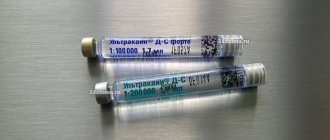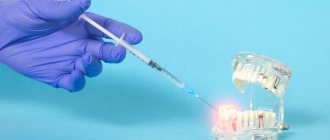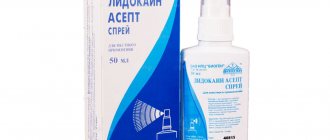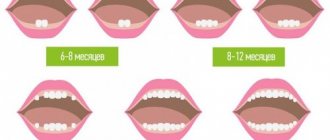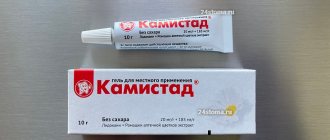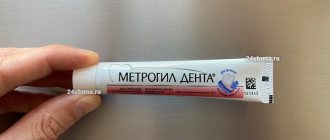Lidocaine – aerosol, gel, spray
Dosed spray for local use. Locally, in dentistry, otolaryngology - 1-4 doses, with endoscopic and instrumental research methods - 2-3 doses, in obstetrics - 15-20 doses, gynecology - 4-5 doses, dermatology - 1-3 doses. The maximum dose is 40 doses/70 kg body weight. In dental practice in children, it is preferable to use it as a lubricant (to avoid frightening the patient when sprayed) by pre-impregnating a cotton swab.
Aerosol dosed for local use. Locally, in dentistry for adults - 20 mg (2 doses), maximum dose - 30 mg (3 doses) over 1.5 hours or 200 mg (20 doses) over 24 hours; children - up to 3 mg/kg.
Gel for external use. Apply externally to the surface of the skin as needed 3-4 times a day.
Gel for topical use. Locally, during anesthesia of the mucous membrane of the esophagus, larynx, trachea, lubricate the outer surfaces of the instruments intended for research; for superficial anesthesia of the oral mucosa, apply 0.2-2 g of gel with a sterile glass rod or a sterile cotton swab soaked in the gel; if anesthesia is insufficient, repeat after 2-3 minutes; the maximum dose for adults in 12 hours is 300 mg (6 g of gel); in urology for women - 3-5 ml of 2% gel lubricate the urethral mucosa before examination, for men before catheterization - 100-200 mg (5-10 ml of 2% gel), before cystoscopy for filling and dilatation of the urethra - 600 mg (30 ml 2 % gel) in 2 doses with an interval of several minutes (the distal urethra is temporarily clamped). The maximum dose is 600 mg (30 ml of 2% gel) for 12 hours. Children - up to 4.5 mg/kg.
Lidochlor. Urology: in men (to achieve anesthesia of the mucous membrane of the urethra) - rinse and disinfect the external opening of the urethra. Break off the inner tip, by squeezing the tube, smoothly introduce the contents (10 g of gel) through the plastic extension and squeeze the channel for a few minutes. For short-term procedures (catheterization), adequate anesthesia is achieved almost immediately after insertion; for a longer procedure (cystoscopy), the canal is clamped for 5-10 minutes to obtain maximum effect; in women, the dose is selected individually depending on the characteristics of the anatomical structure of the urethra. To relieve pain from cystitis and urethritis, 10 g of gel is administered once a day for 5-7 days in combination with other drugs.
Dentistry. To anesthetize the injection site, the gel is applied to the mucous membrane in the area of subsequent infiltration anesthesia at intervals of 2-3 minutes; for anesthesia when removing tartar, the gel is rubbed into the gingival margin and necks of the teeth for 2-3 minutes, after which the procedure is carried out; as a therapeutic dressing after removing tartar or curettage, the gel is applied to the gingival margin and fixed; in the form of applications, it is applied several times a day to the oral mucosa at the sites of aphthae and erosions.
Lidocaine
Lidocaine
(eng.
lidocaine
) is a widely used local anesthetic drug, as well as an antiarrhythmic drug for the treatment of heart disease.
Lidocaine is a chemical compound
The chemical name of lidocaine is 2-(diethylamino)-N-(2,6-dimethylphenyl)acetamide. The empirical formula of lidocaine is C14H22N2O. Molecular weight 234.3373 g/mol.
Lidocaine is a medicine
Lidocaine is the international nonproprietary name (INN) of the drug. According to the pharmacological index, lidocaine is classified in the groups “Antiarrhythmics” and “Local anesthetics”. In the ATC, lidocaine is included in several groups and is assigned the following codes:
- code N01BB02, subgroup “N01B Preparations for local anesthesia”
- code S01HA07, group “S01 Drugs for the treatment of eye diseases”
- code D04AB01, group “D04 Preparations for the treatment of itching (including antihistamines and anesthetics)”
- code C01BB01, subgroup “C01B Antiarrhythmic drugs of classes I and III”
The use of lidocaine in instrumental studies of the gastrointestinal tract
In the Foto.
Anesthesia of the nasal sinuses with lidocaine spray for topical use for the purpose of more comfortable insertion of a pH probe into the nasal passages before a daily study of the acidity of the upper gastrointestinal tract Lidocaine in the form of a dosage form - 10% spray for topical use (see illustrations above) most often Anesthetic agent recommended throughout the world for transnasal administration to a patient:
- pH probes for intragastric pH-metry (Maev I.V. et al.; Sablin O.A. et al.; Stupin V.A. et al.; Rapoport S.I. et al., RF; Warrington S. et al., UK)
- ZpH probes for impedance pH-metry (Trukhmanov A.S., Kaibysheva V.O.; Bordin D.S. et al., RF; Valitova E.R., RF, Bor S., Turkey)
- catheters for esophageal manometry (Freeman J., USA; Bordin D.S., Valitova E.R.; Storonova O.A., Trukhmanov A.S., Russian Federation)
Lidocaine spray is also used for esophagogastroduodenoscopy (Gibadullina L.V., Sannikov O.R.), rectomanoscopy and colonoscopy, when inserted into the anus or when changing a catheter during anorectal manometry, examination of anal fissures (Krylov N.N.), intubation with cerebral edema (Polunina T.E.) or with the introduction of another instrument during research and procedures.
Irrigation of the nasal cavity with lidocaine spray before insertion of a pH probe or catheter is performed with the patient in a sitting position, one dose (“injection”) into one nostril. Irrigation of the pharynx with lidocaine is not recommended, since anesthesia of the pharynx makes it difficult to insert the probe due to suppression of the pharyngeal and cough reflex, and ingestion of lidocaine changes the motility of the upper esophagus (Storonova O.A., Trukhmanov A.S.). As an alternative, it is possible to apply a lubricant with lidocaine to the inserted catheter (Bordin D.S., Valitova E.R.).
Indications for the use of lidocaine
Lidocaine is used for infiltration, conduction, spinal, epidural and terminal anesthesia (including in ophthalmology). Lidocaine is used as a local anesthetic:
- when inserting an instrument into the nose, mouth or anus
- when palpating the anal area
- in dentistry, with:
- anesthesia of the injection area before local anesthesia
- suturing the mucous membrane
- removal of baby teeth
- removal of tartar
- taking material from the oral mucosa (Ostrovskaya L.Yu.)
- instrumental and surgical interventions on the vagina and uterus
- processing of cuts
- removal of seams
In cardiology, lidocaine is used as an antiarrhythmic agent for ventricular extrasystole and tachyarrhythmia, for acute myocardial infarction, in the postoperative period, and for ventricular fibrillation.
Use of lidocaine by pregnant and breastfeeding women
The FDA category of risk for the fetus when using lidocaine in pregnant women is “B” (animal studies have not revealed the risk of adverse effects on the fetus; there have been no adequate studies in pregnant women).
Lidocaine passes into breast milk, so the use of lidocaine (especially its injectable forms) in breastfeeding mothers should be strictly under the supervision of a physician.
Trade names of lidocaine-based drugs and dosage forms
The following drugs with the only active ingredient lidocaine are (have been) registered in Russia:
- Lidocaine
- gel for topical use, 5%
- dosed spray, 100 mg/ml
- spray for topical use, dosed, 10% and 100 mg/ml
- eye drops, 2 and 4%
- injection solution, 1, 2 and 10%, 10, 20, 100 mg/ml
, solution for injection, 1, 2 and 10%
, solution for injection, 1, 2 and 10%
, spray for external and local use 10%
, solution for injection, 2 and 10%
, solution for injection, 1 and 2%
- plates, 700 mg
- transdermal therapeutic systems, 700 mg
, gel for topical use, 2%
, gel for topical use, 2%
, topical gel, 1 and 2.5%
In addition, there are a certain number of medications that include lidocaine as one of several active ingredients, in particular:
- Hydrocortisone-Richter
, suspension for intra-articular and periarticular administration, active ingredients “lidocaine + hydrocortisone”. Used in the treatment of rheumatic diseases accompanied by arthritis. See “Information for medical professionals and specialists” from the manufacturer - Gedeon Richter (pdf). - Lidocaine + Phenazol
, ear drops - Cathegel with lidocaine
, gel for external use, uroantiseptic, active ingredients “lidocaine + chlorhexidine” - Lidocaine Asept
, spray for topical use, uroantiseptic, active ingredients “lidocaine + chlorhexidine” - Consol
, solution for intracoronary infusion, active ingredients “lidocaine hydrochloride + calcium gluconate + potassium chloride + magnesium sulfate + sodium bicarbonate + sodium chloride”
FDA Warning Against the Use of Lidocaine 2% Gel to Relieve Teething Pain in Infants
The FDA, in its June 26, 2014 communiqué, warns that prescription lidocaine 2% oral gel (“viscous solution”) should not be used to relieve teething pain in infants and its use in infants and young children may cause serious harm to them. up to and including death.
Local painkillers and gum medications do not have an effect, as they are washed out of the child’s mouth within a few minutes. When too much lidocaine gel is put into the mouth of infants and young children, they may accidentally swallow large amounts of the drug and this can lead to seizures, severe traumatic brain injury, and heart problems. Cases of overdose, incorrect dosage, or accidental ingestion have resulted in children being hospitalized or dying. In Russia, this communiqué to one degree or another includes, in particular:
- Kamistad
- gel for topical use, active ingredient (per 1 g of gel): lidocaine hydrochloride 20 mg + chamomile flower extract (1:4–5) 185 mg; indications for use, including: pain during the eruption of baby teeth - Dentinox
is a dental gel, active ingredient (per 1 g of gel): lidocaine hydrochloride 3.4 mg + chamomile flower tincture 150 mg; indications for use: prevention of pain and inflammation during the eruption of the first teeth - Kalgel
is a dental gel, active ingredient (per 1 g of gel): lidocaine hydrochloride 3.3 mg + cetylpyridinium chloride 1 mg; indications for use: pain during teething in children from 5 months of age
2% lidocaine is contained only in Kamistad. In Detinox and Kalagel its content is lower, but one must also take into account the general direction of the FDA communiqué against the use of any pharmacological gels to relieve teething pain in infants.
Special instructions when using lidocaine for anesthesia
Regional and local anesthesia should be carried out by experienced specialists in an appropriately equipped room with the availability of equipment and drugs necessary for cardiac monitoring and resuscitation, ready for immediate use. Personnel performing anesthesia should be familiar with the diagnosis and treatment of systemic toxicities, adverse events, and other complications.
Fatalities from the use of injectable lidocaine in 2017
According to the press service of Roszdravnadzor: “In 2021, the Service received two reports from the Republic of Crimea and the Samara region about deaths in patients (41 years and 9 months) due to anaphylactic shock when using the drug “Lidocaine, injection solution... series 020117, produced by Ozon LLC (in one case, the drug “Lidocaine” was used together with the drug “Water for Injection”)... Roszdravnadzor has not received any other reports of adverse reactions of these drugs of the indicated series” (RIA Novosti, 31.8.2017) .
Comment (RIA Novosti, 4.9.2017).
Lidocaine has contraindications, side effects and application features; consultation with a specialist is necessary.
Back to section
